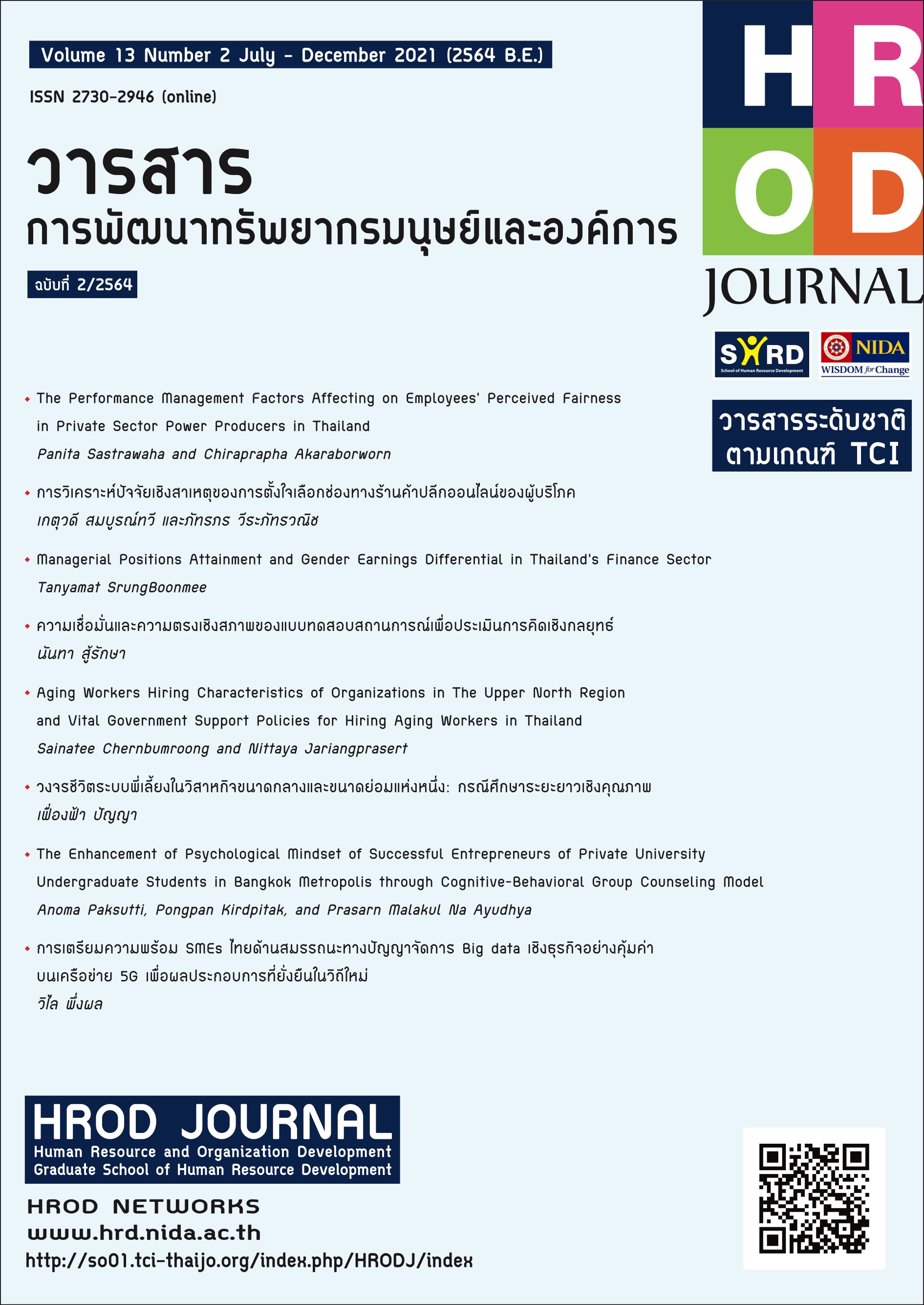Managerial Positions Attainment and Gender Earnings Differential in Thailand’s Finance Sector
Main Article Content
Abstract
This paper uses data from the Thai Labor Force Survey (LFS) from 2012 – 2015 to study gender earnings differential among white collar workers in the Thai finance sector. The Blinder-Oaxaca (Blinder, 1973; Oaxaca, 1973) wage decomposition is employed in the investigation. The main results show a substantial unexplained earnings differential, but smaller than the explained difference. Family obligations do not seem to affect men and women differently. Further investigation reveals that the explained difference owes mostly to fewer females attaining management positions, as they tend to leave the profession at earlier ages than men. Insights from field interviews support the hypothesis that women are not as flexible in their work schedule as men are, while work in this sector often requires meeting clients at irregular hours. The inability or unwillingness of females to work those hours likely weakens their rapport with supervisors, which in turn hurt their chances of promotions.
Article Details

This work is licensed under a Creative Commons Attribution-NonCommercial-NoDerivatives 4.0 International License.
1) The content of article in HROD journal is the author’s wholly responsibility to research, analyze, summarize, compile, and reference data. The editorial department will not be responsible in anyway.
2) The submitted articles in HROD journal must be unpublished before and must not be currently under consideration for publication elsewhere. If it is detected for its repetition, the author must be responsible for infringement of copyright.
3) Authors will be asked to transfer copyright of the article to the Publisher. The article is prohibited to reproduce all or part of the text, unless allowed.
References
Ariyaarpakamol, N. (2019). Urban-rural inequality in Thailand: Differences in characteristics or returns? Kasetsart Journal of Social Sciences, 40(1), 32–39.
Becker, G. S. (1981). A treatise on the family. Cambridge, MA: Harvard University Press.
Blinder, A. S. (1973). Wage discrimination: reduced form and structural estimates. Journal of Human Resources, 8, 436-455.
Bui, M. T., & Permpoonwiwat, C. K. (2015). Gender wage inequality in Thailand: A sectoral perspective. International Journal of Behavioral Science, 10(2), 19-36.
Chun, H., & Lee, I. (2001). Why do married men earn more: productivity or marriage selection? Economic Inquiry, 39(2), 307-319.
Fang, Z., & Sakellariou, C. (2011). A case of sticky floors: Gender wage differentials in Thailand. Asian Economic Journal, 25(1), 35-54.
Gangl, M., & Ziefle, A. (2009). Motherhood, labor force behavior, and women’s careers: An empirical assessment of the wage penalty for motherhood in britain, germany, and the united states. Demography, 46, 341-396.
Gerlach, K., & Schmidt, E. M. (1990). Firm size and wages. LABOUR. https://doi.org/10.1111/j.1467-9914.1990.tb00232.x
Ginther, D. K., & Zavodny, M. (2000). Is the male marriage premium due to selection? The effect of shotgun weddings on the return to marriage. Journal of Population Economics, 14(2), 313-328.
Gorman, E. H. (1999). Bringing home the bacon: Marital allocation of income-earning responsibility, job shifts, and men's wages. Journal of Marriage and the Family, 110-122.
Gray, J. S. (1997). The fall in men's return to marriage: Declining productivity effects or changing selection? The Journal of Human Resources, 32(3), 481-504.
Hersch, J., & Stratton, L. S. (2000). Household specialization and the male marriage wage premium. ILR Review, 54(1), 78-94.
Hungerford, T., & Solon, G. (1987). Sheepskin effects in the returns to education. The Review of Economics and Statistics, 69(1), 175-177.
Jann, B. (2008). A Stata implementation of the Blinder-Oaxaca decomposition. Stata Journal, 8(4), 453-479.
Jithitikulchai, T. (2018). Gender wage inequality in Thailand. Applied Economics Journal, 25(1), 79-97.
Khorpetch, C., & Kulkolkarn, K. (2011). Gender wage discrimination in the Thai labor market (in Thai). Applied Economics Journal, 18(2), 17-31.
Killewald, A., & Gough, M. (2013). Does specialization explain marriage penalties and premiums? American Sociological Review, 78(3), 477–502. doi:10.1177/0003122413484151
Korenman, S., & Neumark, D. (1991). Does marriage really make men more productive? The Journal of Human Resources, 26(2), 282-307.
Kühhirt, M., & Ludwig, V. (2012). Domestic work and the wage penalty for motherhood in West Germany. Journal of Marriage and Family, 74(1), 186-200.
Liao, L., & Paweenawat, S. W. (2020). A glass ceiling? Gender inequality of top earners in Thailand. Economics Bulletin, 40(1), 500-515.
Ludwig, V., & Brüderl, J. (2018). Is there a male marital wage premium? New Evidence from the United States. American Sociological Review, 83(4), 744-770.
Nakavachara, V. (2010). Superior female education: Explaining the gender earnings gap trend in Thailand. Journal of Asian Economics, 21(2), 198-218.
National Statistical Office of Thailand. (2015). Labor force survey (2012 - 2015). [Dataset].
Oaxaca, R. (1973). Male-female wage differentials in urban labor markets. International Economic Review, 14, 693-709.
Oi, W. Y., & Idson, T. L. (1999). Chapter 33 firm size and wages. In Handbook of labor economics (pp. 2165-2214). doi:10.1016/s1573-4463(99)30019-5
Spence, M. (1981). Signaling, screening, and information. In S. Rosen, Studies in labor markets (pp. 319-358). University of Chicago Press.
Weichselbaumer, D., & Winter-Ebmer, R. (2005). A meta-analysis of the international gender wage gap. Journal of Economic Surveys. https://doi.org/10.1111/j.0950-0804.2005.00256.x
Yukongdi, V. (2005). Women in management in Thailand: Advancement and prospects. Asia Pacific Business Review, 11(2), 267-281.

